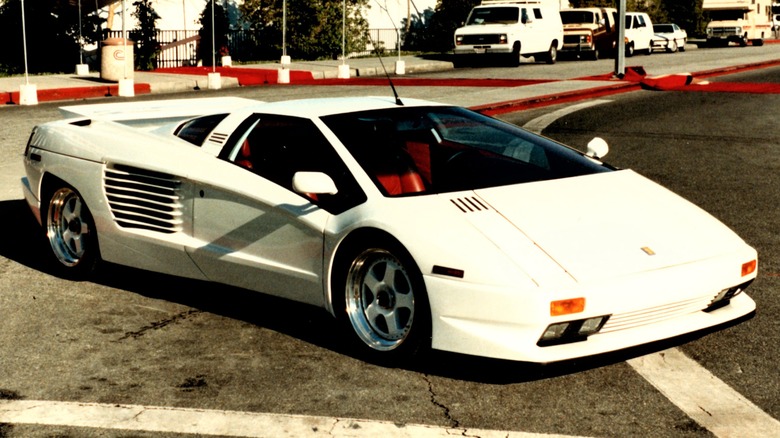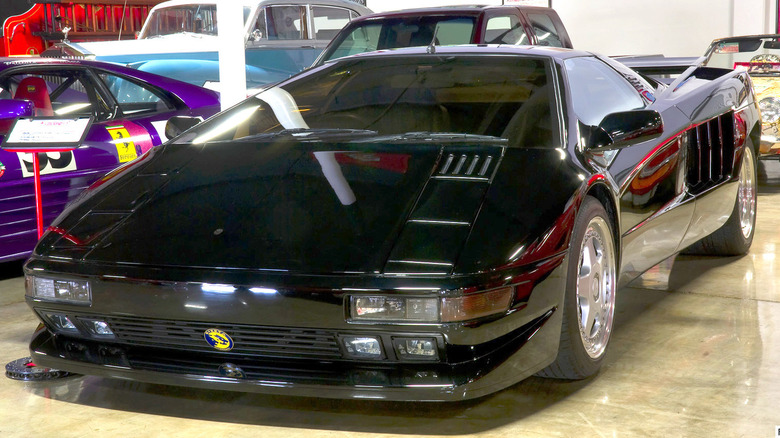Looks Can Be Deceiving: The Intriguing Tale Of A Rare Lamborghini Look-A-Like
Artists will be inspired by those who came before them in the form of homage or imitation. Quentin Tarantino pulls from Brian De Palma, who is pulling from Alfred Hitchcock, and the line continues. Though they may not be thought of as art by many people, automobile designs can be beautiful. A car's shape, color, and material play a significant role in why someone would want to purchase it. So, for car designers, they are inspired just like any other artist. They look to past models and use them as a jumping-off point to create their own distinct work.
When it comes to cars being perceived as beautiful objects, there's no place better to look than Italy, home to Ferrari, Alfa Romeo, and Lamborghini. The latter of the three, in particular, has carved out a space for itself, creating sleek, eye-popping cars that so many manufacturers are still emulating to this day. Look at a Lamborghini Miura P400 from 1966 and see the inspiration everywhere.
One car, in particular, took a page out of the Lamborghini design book perhaps more than any other, which makes sense because it came from folks who worked for Lamborghini. The Cizeta Moroder V16T could be seen as a spiritual successor to Lamborghini's own Countach. Don't let that description make you think this is just some cheap knockoff. No, the Cizeta is as powerful as it is striking, and those with one are among an exclusive club.
[Featured image by Alden Jewell via Wikipedia Commons | Cropped and scaled | CC BY 2.0 DEED]
An engineer, a designer, and a composer
The Cizeta Moroder V16T comes from Italian auto engineer Claudio Zampolli, who worked for Lamborghini before deciding to go to the United States to strike out on his own by running car dealerships and service businesses. The Cizeta portion of the company's name derives from Zampolli's initials. When he decided it was time to develop his car, he knew he needed something bold to stand out from the crowd, saying to Car and Driver, "Ever since I was a kid, I've liked the largest and most powerful cars. I don't knock the V-8 Ferraris and Lamborghinis—they're fine cars—but the car that carries my own initials has to be something special." His solution was to give this car a massive V-16 engine.
Then it came to designing the vehicle's body, and he enlisted big-time Italian designer Marcello Gandini. Further entrenching this car in the history of Lamborghini, Gandini was the designer of that company's Miura, Diablo, and Countach models, crème de la crème of their sports cars. So, the Cizeta Moroder V16T wasn't just inspired by those cars. It was designed by the same person, with his Lamborghini P132 prototype acting as the design base. Crossover was inevitable.
The Cizeta name is accounted for, but what about Moroder? That comes from legendary Italian composer and synthesizer pioneer Giorgio Moroder. He would have his Lamborghini serviced at Zampolli's shop and decided to join Zampolli as a principal financial backer.
[Featured image by Pat Durkin via Wikipedia Commons | Cropped and scaled | CC BY-SA 2.0 DEED]
Slow production and losing a key figure
Though the Cizeta Moroder V16T was introduced in 1989, production on the vehicle would not begin until 1991, and by then, they faced a major setback when, according to Autoweek, Giorgio Moroder decided to pull out of the company after disagreements with Claudio Zampolli about building materials. This is why every unit of the car brandishes the name Cizeta V16T rather than the full name, except for the initial prototype given to Moroder.
You expect a specialty car like this to be expensive, and with the company working with far less money now than they had anticipated, it would take a long time to produce each vehicle. The initial base cost for a car, according to Car and Driver, was about $280,000 (nearly $695,000 today), though Top Gear estimates that went up to about $400,000 in 1991 when production started. Due to its high cost and slow production time, very few units were ever produced. In fact, that number is below 15, making this Lamborghini lookalike with a monster V-16 engine an extremely rare find.
Obviously, this was not a profitable enterprise, and after 1995, the vehicles were built on a special order basis. Back in 2009, Zampolli said to Autoweek, "You don't make money doing this."
Giorgio Moroder auctioned off his original prototype of the car in January 2022, and it sold for a whopping $1.36 million.
[Featured image by Craig Howell via Wikipedia Commons | Cropped and scaled | CC BY 2.0 DEED]


